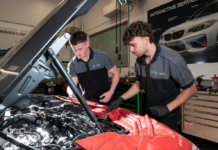
Australia’s automotive industry continues to face critical technician shortages despite a slight national easing in labour market pressures, according to the Victorian Automotive Chamber of Commerce (VACC).
The Jobs and Skills Australia (JSA) 2025 Occupation Shortage List shows the share of occupations in national shortage has fallen from 33% to 29%. However, trades essential to vehicle maintenance and safety remain among the hardest positions to fill.
Persistent shortages continue across key automotive roles including automotive electricians, motor mechanics, diesel motor mechanics, motorcycle mechanics, small engine mechanics, panel beaters, vehicle body builders, vehicle trimmers, vehicle painters, parts and accessories fitters and auto glaziers.
VACC chief executive Peter Jones said the sector has reached a critical point.
“These are the skilled roles that keep workshops operating, vehicles safe and Australians moving — and they are still extremely hard to fill,” Jones said.
“The pressure on automotive businesses is real. Repair wait times are increasing, costs are rising for consumers and small family-run workshops are feeling the strain. Australia cannot afford to ignore this any longer.”
According to industry feedback, one in three automotive businesses report technician vacancies remain unfilled for more than six months, adding to service delays and operational pressure nationwide.
Modernising industry perception
Jones said a shift in public perception is urgently needed to attract the next generation of skilled workers.
“Today’s automotive technicians work with advanced electronics, software diagnostics and zero- and low-emissions vehicle technology — this is a sophisticated, high-tech career,” he said.
“We must position automotive as a first-choice profession for young Australians, not a fallback.”
VACC is calling for strengthened, future-focused training to equip apprentices and technicians with rapidly evolving skills, particularly in zero and low emissions vehicle (ZLEV) systems, advanced driver assistance systems (ADAS) and digital diagnostics.
Government support needed
Jones is urging the Federal Government to support a level playing field for apprenticeships.
“Automotive apprentices deserve the same financial support currently provided to construction apprentices,” he said.
“Matching milestone incentive payments of up to $10,000 would boost apprentice commencements, lift completion rates and strengthen Australia’s future workforce. It’s a practical and fair reform.”
Jones said financial and administrative barriers associated with skilled migration and recognition of prior learning are also holding the industry back, with employers facing high visa fees, lengthy processing delays and inconsistent assessment frameworks.
He added that meaningful change must include a national campaign to reposition automotive careers as innovative and future-focused, targeted incentives for mature-age apprentices, and a dedicated fund to upskill existing technicians in advanced and evolving vehicle technologies.
“The automotive industry is the backbone of Australia’s transport, logistics, emergency services and everyday mobility,” Jones said.
“If we fail to invest in training and workforce development now, Australia risks falling behind just as the global shift to low-emissions transport accelerates.”

Automobile Magazine-AU

























